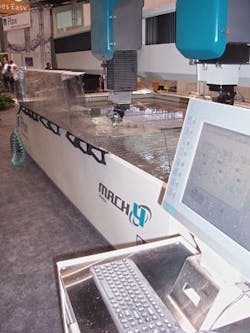To provide this detailed data more efficiently, Flow decided about three years ago that it needed to redo the control architecture on its waterjet cutting machines. "We used to have a PC from one company, motion cards from a second and lots of I/O boards from different suppliers, and so we had some problems with remote diagnostics and troubleshooting when we accessed them via the Internet," Kent says. "When there was an issue with an I/O card, and we tried to figure out whose jurisdiction it was in and who should take responsibility, many of the suppliers pointed fingers at each other. This meant less uptime for our users. Our technicians needed true run data ahead of time so they'd know what problem to fix and what parts to bring. We needed one control architecture."
"This new architecture is much simpler," Kent says. "We have one Cat. 5 cable for control and power, which means about two-thirds less wire, and less labor because we don't have to check our Cat. 5 connections with voltmeters."
So far, B&R Automation hardware and Powerlink networking are standard on Flow's year-old Mach 2 and Mach 4 waterjet cutting machines. B&R's solid-state PC allows it to run at up to 125 °F, which means few parts and more reliability, Kent says. "And, over Powerlink, we can observe the CPU and its temperature on our machines, and see our servo motors and drives and their temperatures more easily. This is a huge benefit to our support department. Previously, we couldn't do as much remote diagnostics because we couldn't see as many details, and so there was more trial and error. Now we don't have to send out technicians blind anymore. They can usually see problems online over a secure VPN that the customer logs onto. We can send out technicians with the right parts, and they can solve more problems right away."
This article is part of November 2012's cover story: "Connect Your Islands of Automation."







